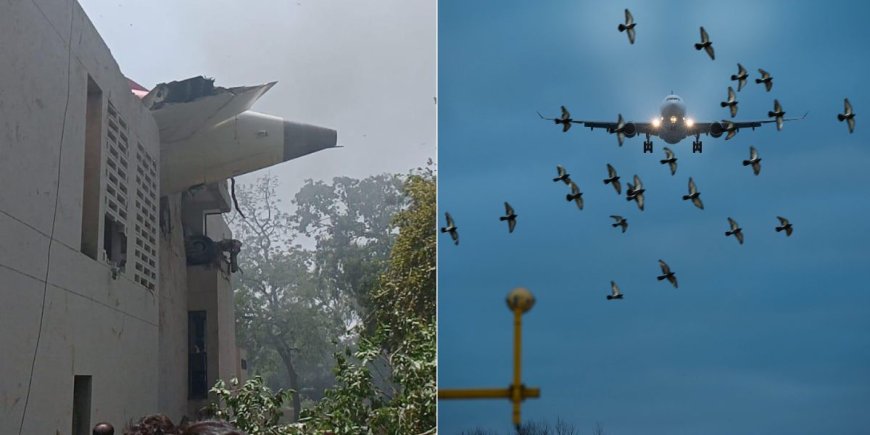EXPLAINED: Can Bird Strikes Cause A Plane Crash?
Bird strikes can damage aircraft engines, sometimes severely. In severe cases, bird strikes can cause engines to lose power

The June 12, 2025, plane crash involving Air India's flight AI171, which has since claimed the lives of 241 people onboard and more on the ground, has sent shockwaves across the global aviation industry.
The exact cause of what went wrong with Flight AI171, which was en route from Ahmedabad to London Gatwick on Thursday afternoon, remains unknown and will only be determined after a thorough investigation.
The initial moments after takeoff are often the most critical in aviation, and that’s when the crash occurred—just 1.5 km (0.9 miles) from the runway at Sardar Vallabhbhai Patel International Airport.
Indian authorities will be joined by aviation experts from the US and UK to investigate the crash, which marked the first fatal crash involving a Boeing 787-8 Dreamliner since the aircraft began commercial flights in 2011.

Wreckage of the Air India Flight 171 crash on June 12, 2025. /BBC
However, even as investigations continue, aviation experts around the world have begun to offer a variety of theories as to what led to the plane crash, which now contributes to over 460 fatalities so far in 2025 in global aviation, significantly exceeding the decade-long average of 284, according to Jan-Arwed Richter, founder of German aviation safety firm Jacdec. The sharp rise underscores growing concerns about flight safety in what is shaping up to be one of the most dangerous years for commercial air travel in recent history.
One possibility raised by some experts in India is a bird strike, which is defined as a collision between a bird and an aircraft that is in flight or during a takeoff or landing roll. Bird strikes can damage aircraft engines, sometimes severely. In severe cases, bird strikes can cause engines to lose power, like in the Jeju Air disaster in South Korea last year that claimed 179 lives.
Experts and pilots familiar with Ahmedabad airport told the BBC the area is “notorious for birds,” with Mr. Ranganathan and at least three Indian pilots confirming that bird activity is a constant issue.
According to data from the Civil Aviation Ministry presented in Parliament in December 2023, Gujarat recorded 462 bird strike incidents over five years, with Ahmedabad airport accounting for the majority. A Times of India report from September 2023 cited Airport Authority figures showing 38 bird strikes at Ahmedabad in 2022–23—a 35% increase from the previous year.
In one 2009 incident, a flock of seagulls was sucked into engines at 2,700 feet—much higher than the altitude at which the Air India crash occurred. However, in this recent case, pilots likely lacked both altitude and time to react. Still, a senior pilot noted that bird strikes rarely lead to disaster—unless both engines are hit.
In Kenya, bird strikes have sparked fears in the aviation sector deemed by many to be young. A recent case occurred on March 25, 2025, when a Kenya Airways (KQ) flight bound for Kisumu from Nairobi had to turn back mid-air.
KQ654 flight was earlier scheduled to fly from Jomo Kenyatta International Airport (JKIA) in Nairobi to Kisumu International Airport in Kisumu. Henry Okatch, KQ's Head of Corporate Communications, told Viral Tea at the time that the incident was a result of a bird strike.
While commercial aircraft are designed to survive single-bird impacts, multiple bird strikes, especially involving large birds, can be catastrophic for an engine, a critical component in terms of the normal operations of an aircraft.
In 2024, KQ 670 flight en route to Kisumu encountered a bird strike at around 6:36 pm. All crew and passengers disembarked safely, but the aircraft was unable to exit the runway after the bird strike damaged its steering components.
For 2024 alone, the airline reported losses of USD 3,646,405 (KSh 472.3 million) due to bird strikes, based on the current exchange rate of 1 USD = KSh 129.53. This amount is nearly equivalent to Kenya Airways' Ksh513 million profit for the first half of 2024, underscoring the significant financial burden of operating an airline.
In 2023, KQ suffered losses of USD 9,017,251 (KSh 1.16 billion) from bird strikes. The previous years also saw substantial financial impacts:
-
2022: USD 6,135,235 (Ksh794.7 million)
-
2021: USD 6,373,202 (Ksh825.5 million)
-
2020: The worst year, with USD 46.3 million (Ksh6 billion) in damages.
-
2019: USD 3,224,349 (Ksh417.6 million).
The High Cost of Bird Strikes
Aviation experts note that after a bird strike, an aircraft may be grounded for a week or longer, depending on the extent of the damage. If a bird remains in contact with a jet engine, they can shatter multiple blades, leading to extensive repairs. The damage is further exacerbated by the high velocity at which aircraft operate.
-
A single blade in some jet engines can cost up to Ksh259 million.
-
Replacing a Dreamliner 787 engine from General Electric could cost over Ksh4 billion.
-
In cases of severe damage, airlines install spare engines to keep flights operational while repairs are conducted.
Beyond repair costs, bird strikes also cause flight delays, triggering ripple effects such as passenger rebookings, accommodation expenses, and operational disruptions.
The global aviation industry has lost over Ksh544 billion due to bird strikes. While eliminating birds near airports would be the most effective solution, Kenya Wildlife Services (KWS) prohibits such measures, considering them inhumane. Instead, the Kenya Airports Authority (KAA) employs personnel to scare birds away from runways.
One of the biggest factors attracting birds near flight paths is the large dumpsites in Nairobi’s Embakasi area, which serve as feeding grounds.







